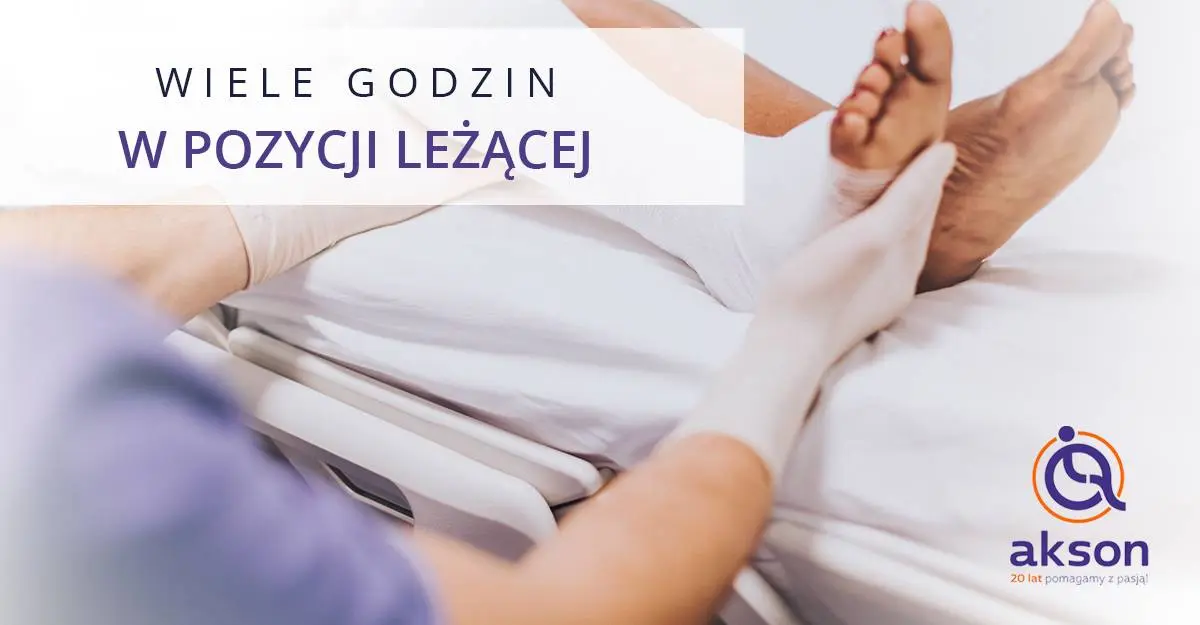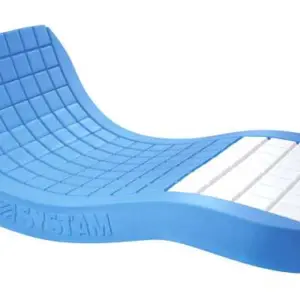Your cart is currently empty!

A patient who is lying down for a long time – how to organize his care?
Sometimes illness forces a loved one to spend most of the day in a reclining position. Then a lot of questions arise in our mind: is our body adapted to it? What are the consequences of spending many hours lying down? What equipment to choose, where to look for help and funds?
Jakie są konsekwencje długotrwałego leżenia?
Do jednych z nich należy powstanie odleżyn. Na odleżyny najbardziej narażone są: odcinek krzyżowy – głównie kość ogonowa kręgosłupa, łopatki, łokcie, pięty, oraz potylica. Odleżyny mogą pojawić się w ciągu zaledwie kilku godzin, a walka z już istniejącymi odleżynami nie należy do łatwych. Najszybszym sposobem jest odciążenie okolic narażonych na powstawanie ran, poprzez podkładanie krążków przeciwodleżynowych. Jednak zdecydowanie najważniejszą rzeczą jest materac przeciwodleżynowy. Warto zadbać o to, aby jak najwcześniej zaopatrzyć chorego w taki produkt – poprzez ciągłą pracę zapewnia on dopływ powietrza do okolic narażonych na odleżyny, co w efekcie zapobiega tworzeniu lub pogłębianiu się ran. Na rynku mamy kilka rodzajów materacy w wersji podstawowej oraz z systemem osuszania, np. Airflo 250F lub Airflo z systemem osuszania. Plusem jest to, że materace przeciwodleżynowe są częściowo refundowane przez NFZ – wystarczy udać się do lekarza rodzinnego w poradni ogólnej po zlecenie na zaopatrzenie lub poprosić o takie zlecenie przy okazji wizyty u lekarza specjalisty. Pamiętajmy, że zgodnie z aktualnymi przepisami, wizyta nie musi odbywać się na wizytach lekarskich w ramach Narodowego Funduszu Zdrowia.

Can an anti-decubitus mattress be put on a regular bed?
Tak, pod warunkiem, że nie będzie to zagrażało pacjentowi. Materac przeciwodleżynowy ma wysokość od 6,5 do 11 cm, a przez to, że jest w niego pompowane powietrze w trybie zmiennym, sprawia wrażenie falowania. Właściwe zabezpieczenie chorego zapewni nam posiadanie łóżka rehabilitacyjnego. Każdy z dostępnych modeli jest dostosowany do potrzeb osoby leżącej, jak również opiekuna. Nawet najprostszy model, jak np. Luna Basic 2, odpowiednio obudowane, sterowane pilotem łóżko z regulowanych wezgłowiem, niezwykle ułatwi codzienną pielęgnację chorego. Większość dostępnych łóżek jest sterowanych za pomocą pilota, dzięki czemu możemy regulować np. wysokość łóżka lub pozycje leża. Funkcja ta powoduje, że dbamy również o swoje zdrowie i kręgosłup. Łóżko posiada metalowy lub drewniany stelaż, który w zależności od modelu regulowany jest w wielu pozycjach. Posiada również blokadę kół, opuszczane barierki oraz wysięgnik.
Jeśli chory ma zgodę lekarza do wstawania z łóżka, należy odpowiednio zabezpieczyć mieszkanie, np. usunąć chodniki, aby chory nie potknął się oraz przesunąć meble pod ścianę, aby nie tworzyły przeszkody. Można także zaopatrzyć chorego w: balkonik, kule, trójnóg, czwórnóg lub laskę, aby ułatwić mu przemieszczanie się. Wszystkie te pomoce w poruszaniu się, są częściowo refundowane przez Narodowy Fundusz Zdrowia. Natomiast łóżka rehabilitacyjne nie są niestety refundowane przez NFZ, ale istnieje możliwość wypożyczenia ich na czas nieokreślony.
What else can prolonged lying of the patient lead to?
In addition to bedsores, prolonged lying down can lead to: a decrease in muscle tone, weakening of the body, urinary and respiratory tract infections, which can eventually even lead to pneumonia. Through simple breathing exercises, such as inflating a balloon, blowing air through a tube, or using more professional equipment such as a breathing trainer, we force the patient’s lungs to work. It is also important to remember to regularly ventilate the room in which the patient resides. The temperature in the room should be 18 – 20 ℃. However, the patient’s comfort should not be overlooked.
In order for a patient who is lying down for a long period of time to be in good physical condition, it is essential to make sure that he or she exercises his or her muscles and joints properly. Lifting legs and arms, flexing joints, improving circulation, such as by squeezing a rubber or gel ball with the hand. It is important to remember to pat the sick person’s back and rub with the appropriate agents.
Opieka nad osobą leżąca wymaga właściwego transferu osoby chorej w samym łóżku, jak również z jednego miejsca na drugie. Należy przy tym pamiętać o ochronie swojego kręgosłupa. Pomocne okazuje się wspomniane łóżko rehabilitacyjne, ale także łatwoślizg i podnośnik.
What is an easy slide?
Frequent changes in body position help counteract the formation of bedsores. It is also important to keep your own health in mind when caring for a patient who is lying down for a long period of time. For this purpose, an easy slip was created.
Łatwoślizg, to produkt ułatwiający obracanie chorego, przesuwanie chorego w łóżku, z łóżka na wózek albo na krzesło. Produkt wykonany jest z bardzo trwałej tkaniny, odpornej na rozerwanie. Używając go dbamy nie tylko o swój kręgosłup, ale również o komfort chorego, ponieważ ten produkt pomocny jest przy zmianie pościeli czy też wykonaniu czynności toaletowych w łóżku. Samo utrzymanie łatwoślizgu w czystości jest bardzo proste. Zabrudzone miejsca możemy przetrzeć wilgotną szmatką, a w przypadku powstania dużych zabrudzeń, możemy wyprać łatwoślizg w pralce, w temperaturze nawet do 95 ℃.
How will the elevator help us and is it reimbursed by the National Health Service?
Podnośnik, np. Birdie przeznaczony jest do bezpiecznego podnoszenia i opuszczania pacjenta. Podnośnik z łatwością można rozłożyć na dwa elementy i w razie potrzeby przetransportować samochodem.
This product is unfortunately not reimbursed by the National Health Fund. However, you can apply for funding from other institutions, ie: Provincial Center for Family Assistance (PCPR), Municipal Social Assistance Center (MOPS) or the State Fund for Rehabilitation of Persons with Disabilities (PFRON). We encourage you to take advantage of this type of assistance.
We help with passion!
Jakie są podstawowe potrzeby pacjenta leżącego?
Podstawowe potrzeby pacjenta leżącego obejmują dbanie o higienę, właściwe odżywianie, regularne zmiany pozycji ciała, rehabilitację oraz wsparcie emocjonalne.
Jakie opcje opieki są dostępne dla pacjenta leżącego?
Opcje opieki dla pacjenta leżącego obejmują opiekę świadczoną przez rodziny, opiekunów indywidualnych, opiekę domową przez specjalistyczne agencje oraz opiekę w placówkach opiekuńczo-leczniczych.





